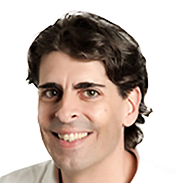
Developing the AOTrauma Orthogeriatrics App
Since its launch in September 2014, the new AOTrauma Orthogeriatrics App has been downloaded by over 12'000 users worldwide. The app addresses four medical aspects of fracture management in older adults and was developed by a planning committee within the AOTrauma Orthogeriatrics Education Taskforce (ETF).
Read an interview with
Tobias Roth and Katrin Singler
The following three geriatricians and one surgeon are the main authors of the app modules: Katrin Singler, MD, MME, Department of Geriatrics, Klinikum Nürnberg, Paracelsus Medical University and Institute for Biomedicine of Aging; Friedrich-Alexander-Universität Erlangen-Nürnberg, Germany, Markus Gosch, MD, Department of Geriatrics, Klinikum Nürnberg, Paracelsus Private Medical University, Germany; Sacha Beck, MD, MHA, Stadtspital Waid, Zurich, Switzerland; and Tobias Roth, MD, Department of Trauma Surgery, Medical University of Innsbruck, Austria.
The authors were supported by a large group of colleagues, peer reviewers, and test users during the development and successful implementation of the app.
Initial evaluation findings
The module authors will soon publish findings from the initial evaluation of the app. Since its launch, 734 surgeons, residents, and other healthcare professionals from almost every country around the world have registered, and 100 have completed an online evaluation. Ratings for all aspects are 4 or higher on a 1–5 Likert scale (5=Excellent), with 80% of respondents stating that they found the answer to their question or educational need on their last visit.

 An interview with Tobias Roth and Katrin Singler
An interview with Tobias Roth and Katrin Singler
Doctors Roth and Singler share some of their experiences from the development of the app, which required considerable thought, time, teamwork, and testing.
Why was the app developed?
TR: It is very important for a trauma surgeon to play a role in managing and treating medical issues, especially osteoporosis, delirium, pain, and anticoagulated patients. Some departments, like ours, are fortunate to have a geriatrician in a comanagement team, while others have different systems of care. We have delivered many courses and some webinars on these topics in orthogeriatrics over recent years and we wanted to reach a wider audience that might not be able to attend courses or get time away from their practice.
KS: Older adults are often very complex due to comorbidities, polypharmacy, or frailty and we wanted to provide educational advice on how to treat these challenging situations. We believed that many surgeons, residents, and other members of the healthcare team would benefit from a "point-of-care" educational tool that they could use in their hospital or at home.
How did you design the content and the app?
TR: The idea of presenting educational content in a pathway was developed and published for osteoporosis and secondary fracture prevention by Markus Gosch. Katrin Singler, Sacha Beck, and I used this approach to develop the other three modules. Our educational tool can guide the doctor with managing many patients based on the latest literature and evidence. Some complex patients may require more specialist management and the app also helps colleagues within the team to discuss their options.
KS: We developed the content based on international and national guidelines and the most recent evidence as much as possible. The authors also had a lot of clinical expertise and teaching experience, and had gathered the questions they had often been asked on AOTrauma courses. It is very important that all of our app users clearly understand that it is an educational tool only, and like with all other education, the responsibility for any decision made in clinical practice is their sole responsibility as a healthcare professional.
What was different about developing content for an app?
TR: One of the main difficulties with the anticoagulation module was the lack of literature on this topic, especially regarding geriatric fracture patients, so it was not easy to formulate pathways based on evidence-based guidelines. Getting the correct amount and level of content, and building it for an international audience—as there are different medications and approaches in the various regions—was also an interesting challenge. Also, we wanted the app to be available on both tablet devices and on smartphones, and some have very small screens for content. It's easy to add a slide in a course presentation but an extra app screen requires detailed integration and programming.
KS: We wanted to keep the app very practice-oriented so that it could be used in the office, at home, or on the ward. We had to build the content around the most important questions and steps and pathways through care. In the delirium module, our first question "Is the patient confused?" allows the user to select ‘Yes’, ‘No’, or ‘I'm not sure’, and then to proceed through a step-by-step line of questioning to get the information needed to make decisions. We decided to create accompanying posters to give the user an overview of the full pathway options.
Key references for content in the app
- Gosch M, Kammerlander C, Roth T, et al. Surgeons save bones: an algorithm for orthopedic surgeons managing secondary fracture prevention. Arch Orthop Trauma Surg. 2013;133 (8):1101–1108. http://www.ncbi.nlm.nih.gov/pubmed/23681470
- Wendl-Soeldner MA, Moll CW, Kammerlander C, et al. Algorithm for anticoagulation management in geriatric hip fracture patients-Surgeons save Blood. Z Gerontol Geriatr. 2014 Feb;47(2):95–104. http://www.ncbi.nlm.nih.gov/pubmed/24619040
AOTrauma
www.aotrauma.com | education@aotrauma.org
Copyright © 2015 AO Foundation. All rights reserved.

